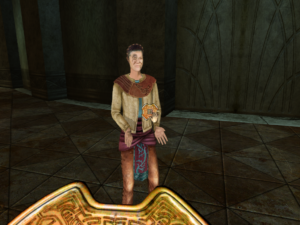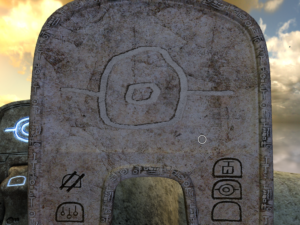Final Fantasy V: Backstories
Progress is still slow. I’ve managed to swap one unpursuable quest for a different, equally unpursuable quest: apparently the last crystal is in orbit or something, and to reach it, I need some adamantine to upgrade my airship. This is the first mention of adamantine I’ve seen. I really hope I break out of this rut soon. I don’t recall anything like this happening in any of the other Final Fantasy games.
In the meantime, let’s take a look at what I’ve learned about the player characters.
First in line is Bartz. That isn’t actually his name in the version I’m playing; unique among the characters, the game lets the player name him, without even suggesting a default. He’s clearly intended as the viewpoint character, and is the only character you control from the very beginning. He’s also something of a prototype for later Final Fantasy heroes like Cloud in FF7: a laconic loner who’s reluctant at first to get involved. I’ll have more to say about him after I’ve described the others.
Second, there’s Princess Reina, whose chief attribute in the plot is that she’s a celebrity. Whenever we arrive at a castle, people recognize her and tell her what an honor it is and so forth, and suddenly it’s her story and the rest of the party is merely her entourage. She’s looking for her father, the king of Tycoon, who vanished shortly before the destruction of the first crystal. I’ve caught a few glimpses of what appears to be the king, always a step ahead, like the G-Man in Half-Life. Reina insists that these glimpses means he’s still alive, although, on the basis of his behavior, I’d say he’s either appearing as a ghost in order to guide us as best he can, or he’s trying to keep ahead of and avoid us because he’s turned into a minion of evil.
Counterpoint to Reina is the pirate captain Faris, whose ship the party attempts to steal early in the game. When this attempt fails and the pirates take you prisoner, Faris decides to hold Reina for ransom. In a surprising twist, Faris is then revealed to be a woman. That is to say, it isn’t surprising that she’s a woman, it’s surprising that this is supposed to be a revelation. She has long pink hair, for crying out loud. The first time I saw an NPC refer to her with a masculine pronoun, I thought he must be talking about someone else. Anyway, not only is she a she, it turns out she’s Reina’s long-lost sister, and a princess in her own right. Both Faris and Reina basically react to this news with “OMG Squeee!” So Faris abandons the ransom plot and joins Reina’s search. Her story arc seems to be mainly about coming to terms with her new station in life. But it should be noted that Faris’ crew displays the same kind of devotion to her as Reina’s people do to Reina. Blood will out?
Next up is an old guy named Galuf, who starts the game with amnesia. At that point, he knows that he’s obliged to protect the crystals, but doesn’t know why, or where he comes from. Well, by now I’ve reached the point where his memory comes back — memories of his granddaughter, his membership in the secret order that placed the crystals in the first place (is he even older than he looks?), and his freaking extraterrestrial origins. The real purpose of the crystals, it seems, is that they form a magical prison for an alien sorcerer called X-Death. Galuf came to this world to help create this prison, then stayed to watch over it, and, over time, went native.
So, basically, we have a bunch of history, including family connections, for each of the main characters except Bartz, who doesn’t even have a proper name in this edition. He’s the empty shell for you to project yourself into. This is probably why I found it moving when I found his home town.
It’s nestled in a forest surrounded by mountains, impossible to reach by airship: only a chocobo will do. It’s full of people who grew up with you and are pleased to see you return. They don’t say a lot, and there’s a bit of a less-is-more thing going on with that. But mainly, I was by this point accustomed to the idea that the viewpoint character is aloof from this world, and not directly engaged in anyone’s story, not even his own. So the effect is based not just on the idea that these people care about you/him, but that this was unexpected. Unexpected caring is the sweetest kind.
 Comments(1)
Comments(1)


